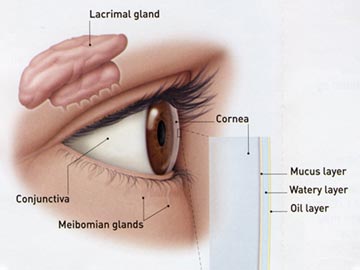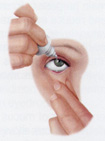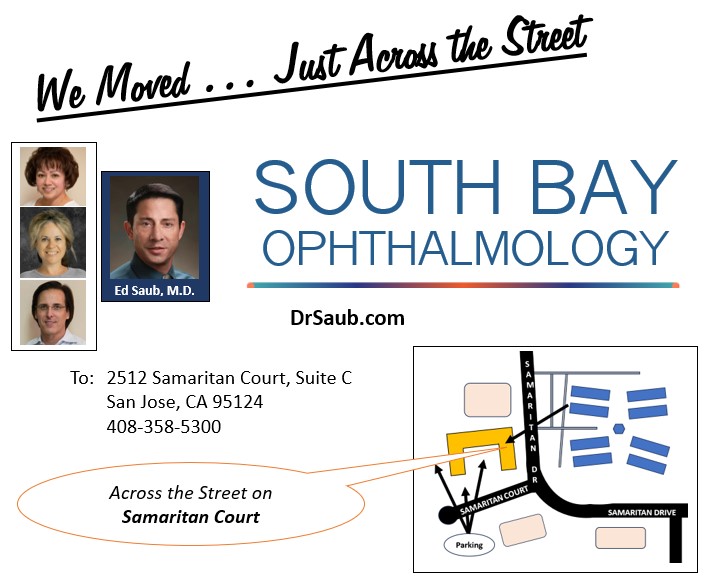Dry Eye
What is dry eye?
Normally, the eye constantly bathes itself in tears. By producing tears at a slow and steady rate, the eye stays moist and comfortable. Sometimes people do not produce enough tears or the appropriate quality of tears to keep their eyes healthy and comfortable. This condition is known as dry eye.
The eye uses two different methods to produce tears. It can make tears at a slow, steady rate to maintain normal eye lubrication. It can also produce large quantities of tears in response to eye irritation or emotion. When a foreign body or dryness irritates the eye, or when a person cries, excessive tearing occurs.
What are the symptoms of dry eye?
The usual symptoms include:
- stinging or burning eyes;
- scratchiness;
- stringy mucus in or around the eyes;
- excessive eye irritation from smoke or wind;
- excess tearing;
- discomfort when wearing contact lenses.
Excess tearing from “dry eye” may sound illogical, but it can be understood as the eye’s response to discomfort. If the tears responsible for maintaining lubrication do not keep the eye wet enough, the eye becomes irritated. Eye irritation prompts the gland that makes tears (called the lacrimal gland) to release a large volume of tears, overwhelming the tear drainage system. These excess tears then overflow from your eye.

Tears have three layers, each with important functions.
What is the tear film?
When you blink, a film of tears spreads over the eye, making the surface of the eye smooth and clear. Without this tear film, good vision would not be possible.
The tear film consists of three layers:
- an oily layer
- a watery layer;
- a layer of mucus.
Each layer has its own purpose.
(See video: Tears Have Three Important Layers)
The oily layer, produced by the meibomian glands, forms the outermost surface of the tear film. Its main purpose is to smooth the tear surface and reduce evaporation of tears.
The middle watery layer makes up most of what we ordinarily think of as tears. This layer, produced by the lacrimal glands in the eyelids, cleanses the eye and washes away foreign particles or irritants.
The inner layer consists of mucus produced by the conjunctiva. Mucus allows the watery layer to spread evenly over the surface of the eye and helps the eye remain moist. Without mucus, tears would not stick to the eye.
What causes dry eye?
Tear production normally decreases as we age. Although dry eye can occur in both men and women at any age, women are most often affected. This is especially true after menopause.
Dry eye can also be associated with other problems. For example, people with dry eyes, dry mouth, and arthritis are said to have Sjogren’s syndrome.
A wide variety of common medications-both prescription and over-the-counter-can cause dry eye by reducing tear secretion. Be sure to tell your ophthalmologist (Eye M.D.) the names of all medications you are taking, especially if you are using:
- diurectics for high blood pressure;
- beta-blockers for heart or high blood pressure;
- antihistamines for allergies;
- sleeping pills;
Since these medications are often necessary, the dry eye condition may have to be tolerated or treated with eye drops called artificial tears.
People with dry eye are often more prone to the toxic side effects of eye medications, including artificial tears. For example, the preservatives in certain eye drops and artificial tear preparations can irritate the eye. These people may need special preservative-free artificial tears.
How is dry eye diagnosed?
An ophthalmologist is usually able to diagnose dry eye by examining the eyes. Sometimes tests that measure tear production are necessary. One test, called the Schirmer tear test, involves placing filter-paper strips under the lower eyelids to measure the rate of tear production under various conditions. Another test uses a diagnostic drop to look for certain patterns of dryness on the surface of the eye.
How is dry eye treated?
ADDING TEARS
 Eye drops called artificial tears are similar to your own tears. They lubricate the eyes and help maintain moisture. Artificial tears are available without prescription. There are many brands of the market, so you may want to try several to find the one you like best.
Eye drops called artificial tears are similar to your own tears. They lubricate the eyes and help maintain moisture. Artificial tears are available without prescription. There are many brands of the market, so you may want to try several to find the one you like best.
Preservative-free eye drops are available for people who are sensitive to the preservatives in artificial tears. If you need to use artificial tears more than every two hours, preservative free brands may be better for you.
CONSERVING YOUR TEARS
Conserving your eyes’ own tears is another approach to keeping the eyes moist. Tears drain out of the eye through a small channel into the nose (which is why your nose runs when you cry). Your ophthalmologist may close these channels either temporarily or permanently. The closure conserves your own tears and makes artificial tears last longer. See a short video on Punctal Occlusion for Dry Eyes.
OTHER METHODS
Tears evaporate like any other liquid. You can take steps to prevent evaporation. In winter, when indoor heating is in use, a humidifier or a pan of water on the radiator adds moisture to dry air. Wrap-around glasses may reduce the drying effect of the wind, but you should note that they are illegal to wear while driving in some states.
A person with dry eye should avoid anything that may cause dryness, such as overly warm room, hair dryers, or wind. Smoking is especially bothersome.
Some people with dry eye complain of “scratchy eyes” when they wake up. This symptom can be treated by using an artificial tear ointment or thick eye drops at bedtime. Use the smallest amount necessary for comfort, since the ointment can cause your vision to blur.
Dry eye due to a lack of vitamin A in the diet is rare in the United States but is more common in poorer countries, especially among children. Ointments containing vitamin A can help dry eye if it is caused by unusual conditions such as Stevens-Johnson syndrome or pemphigoid. Vitamin A Supplements do not seem to help people with ordinary dry eye.
Resources
For more information on dry eye, contact the following organization:
Sjogren’s Syndrome Foundation
6707 Democracy Blvd., Suite 325
Bethseda, MD 20817
(301) 530-4420 or (800) 475-6473
www.sjogrens.org
- Anatomy of the Eye
- Botox
- Cataracts
- Diabetes and the Eye
- Diabetic Retinopathy – What is it and how is it detected?
- Treatment for Diabetic Retinopathy
- Non-Proliferative Diabetic Retinopathy (NPDR) – Video
- Proliferative Diabetic Retinopathy (PDR) – Video
- Cystoid Macular Edema
- Vitreous Hemorrhage – Bleeding from diabetes (Video)
- Vitrectomy Surgery for Vitreous Hemorrhage (Video)
- Macular Edema
- Laser Procedures for Macular Edema (Video)
- Laser for Proliferative Diabetic Retinopathy – PDR (Video)
- How the Eye Sees (Video)
- Dilating Eye Drops
- Dry Eyes and Tearing
- Eye Lid Problems
- A Word About Eyelid Problems
- Bells Palsy
- Blepharitis
- Blepharoptosis – Droopy Eyelids (Video)
- Dermatochalasis – excessive upper eyelid skin (Video)
- Ectropion – Sagging Lower Eyelids (Video)
- Entropion – Inward Turning Eyelids (Video)
- How to Apply Warm Compresses
- Ocular Rosacea
- Removing Eyelid Lesions
- Styes and Chalazion
- Twitches or Spasms
- Floaters and Flashes
- Glaucoma
- Selective Laser Trabeculoplasty (SLT) for Glaucoma
- Glaucoma: What is it and how is it detected?
- Optical Coherence Tomography OCT – Retina & Optic Nerve Scan
- Treatment for Glaucoma
- Retinal Nerve Fibers and Glaucoma (Video)
- Open Angle Glaucoma (Video)
- Closed Angle Glaucoma (Video)
- Visual Field Test for Glaucoma
- Glaucoma and Blind Spots (Video)
- Treatment for Glaucoma with Laser Iridotomy (Video)
- Laser Treatment for Glaucoma with ALT and SLT (Video)
- Surgical Treatment for Glaucoma with Trabeculectomy (Video)
- Surgical Treatment of Glaucoma with Seton (Video)
- Keeping Eyes Healthy
- Laser Vision Correction
- Latisse for Eyelashes
- Macular Degeneration
- Macular Degeneration – What is it and how is it detected?
- Treatment for Macular Degeneration
- Dry Macular Degeneration (Video)
- Wet Macular Degeneration (Video)
- Treatment of Macular Degeneration with Supplements
- Treatment of Wet Macular Degeneration with Anti-VEGF Injections
- Amsler Grid – A home test for Macular Degeneration (Video)
- Living with Vision Loss
- How the Eye Works – The Macula (Video)
- Other Eye Conditions
- Central Serous Retinopathy
- Lattice Degeneration of the Retina
- A Word About Other Eye Conditions
- Amblyopia
- Carotid Artery Disease and the Eye
- Fuch’s Corneal Dystrophy
- Herpes Simplex and the Eye
- Herpes Zoster (Shingles) and the Eye
- Ischemic Optic Neuropathy
- Keratoconus
- Macular Hole
- Macular Pucker
- Microvascular Cranial Nerve Palsy
- Migraine and the Eye
- Optic Neuritis
- Pseudotumor Cerebri
- Retinal Vein Occlusion
- Retinitis Pigmentosa
- Retinopathy of Prematurity
- Strabismus
- Thyroid Disorders and the Eye
- Uveitis
- Vitreomacular Adhesions / Vitreomacular Traction Syndrome
- Red Eye
- Refractive Errors
- Retinal Tears and Detachments
Disclaimer
This Patient Education Center is provided for informational and educational purposes only. It is NOT intended to provide, nor should you use it for, instruction on medical diagnosis or treatment, and it does not provide medical advice. The information contained in the Patient Education Center is compiled from a variety of sources. It does NOT cover all medical problems, eye diseases, eye conditions, ailments or treatments.
You should NOT rely on this information to determine a diagnosis or course of treatment. The information should NOT be used in place of an individual consultation, examination, visit or call with your physician or other qualified health care provider. You should never disregard the advice of your physician or other qualified health care provider because of any information you read on this site or any web sites you visit as a result of this site.
Promptly consult your physician or other qualified health provider if you have any health care questions or concerns and before you begin or alter any treatment plan. No doctor-patient relationship is established by your use of this site.


